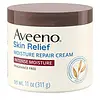What's inside
What's inside
 Key Ingredients
Key Ingredients

 Benefits
Benefits

 Concerns
Concerns

 Ingredients Side-by-side
Ingredients Side-by-side

Water
Skin ConditioningXylitol
HumectantGlycerin
HumectantButyrospermum Parkii Butter
Skin ConditioningOleyl Erucate
EmollientPropanediol
SolventMyristyl Myristate
EmollientShea Butter Ethyl Esters
EmollientVaccinium Myrtillus Fruit Juice
Skin ConditioningC12-16 Alcohols
EmollientCanola Oil
EmollientPentylene Glycol
Skin ConditioningGlyceryl Stearate
EmollientCetyl Alcohol
EmollientBetaine
HumectantAvena Sativa Kernel Oil
Skin ConditioningAvena Sativa Kernel Extract
AbrasiveInulin
Skin ConditioningHydrogenated Oat Kernel Oil
EmollientVaccinium Myrtillus Seed Oil
Skin ConditioningCeramide NP
Skin ConditioningCeramide AP
Skin ConditioningPhytosphingosine
Skin ConditioningCholesterol
EmollientCeramide EOP
Skin ConditioningHydrogenated Lecithin
EmulsifyingPalmitic Acid
EmollientTocopherol
AntioxidantSaccharide Isomerate
HumectantCetearyl Alcohol
EmollientBrassica Campestris Sterols
EmollientEthylhexylglycerin
Skin ConditioningHydroxyacetophenone
AntioxidantHelianthus Annuus Seed Oil
EmollientSodium Gluconate
Skin ConditioningSclerotium Gum
Emulsion StabilisingPhenoxyethanol
PreservativeCetyl Hydroxyethylcellulose
Emulsion StabilisingPolyglyceryl-10 Stearate
Skin ConditioningTriethyl Citrate
MaskingPolyglyceryl-6 Behenate
Emulsion StabilisingCitric Acid
BufferingSodium Citrate
BufferingSodium Carrageenan
Emulsion StabilisingBehenic Acid
CleansingSodium Levulinate
Skin ConditioningPotassium Sorbate
PreservativeMaris Sal
Skin ConditioningDisodium Phosphate
BufferingHydrated Silica
AbrasiveSilica Dimethyl Silylate
EmollientSodium Cetearyl Sulfate
CleansingRosmarinus Officinalis Leaf Extract
AntimicrobialWater, Xylitol, Glycerin, Butyrospermum Parkii Butter, Oleyl Erucate, Propanediol, Myristyl Myristate, Shea Butter Ethyl Esters, Vaccinium Myrtillus Fruit Juice, C12-16 Alcohols, Canola Oil, Pentylene Glycol, Glyceryl Stearate, Cetyl Alcohol, Betaine, Avena Sativa Kernel Oil, Avena Sativa Kernel Extract, Inulin, Hydrogenated Oat Kernel Oil, Vaccinium Myrtillus Seed Oil, Ceramide NP, Ceramide AP, Phytosphingosine, Cholesterol, Ceramide EOP, Hydrogenated Lecithin, Palmitic Acid, Tocopherol, Saccharide Isomerate, Cetearyl Alcohol, Brassica Campestris Sterols, Ethylhexylglycerin, Hydroxyacetophenone, Helianthus Annuus Seed Oil, Sodium Gluconate, Sclerotium Gum, Phenoxyethanol, Cetyl Hydroxyethylcellulose, Polyglyceryl-10 Stearate, Triethyl Citrate, Polyglyceryl-6 Behenate, Citric Acid, Sodium Citrate, Sodium Carrageenan, Behenic Acid, Sodium Levulinate, Potassium Sorbate, Maris Sal, Disodium Phosphate, Hydrated Silica, Silica Dimethyl Silylate, Sodium Cetearyl Sulfate, Rosmarinus Officinalis Leaf Extract
Water
Skin ConditioningGlycerin
HumectantDistearyldimonium Chloride
Petrolatum
EmollientIsopropyl Palmitate
EmollientCetyl Alcohol
EmollientDimethicone
EmollientAvena Sativa Kernel Flour
AbrasiveAvena Sativa Kernel Oil
Skin ConditioningAvena Sativa Kernel Extract
AbrasiveButyrospermum Parkii Butter
Skin ConditioningCaprylyl Glycol
EmollientPhenoxyethanol
PreservativeSteareth-20
CleansingSodium Chloride
MaskingIngredients Explained
These ingredients are found in both products.
Ingredients higher up in an ingredient list are typically present in a larger amount.
Avena Sativa Kernel Extract is is derived from colloidal oatmeal. Besides being a healthy breakfast, oats have many benefits in skincare too.
This ingredient helps sooth, hydrate, and protect the skin. The starches in colloidal oatmeal are able to bind water, keeping the skin hydrated.
The cellulose and fiber in colloidal oatmeal help reduce inflammation. This can also help the skin feel softer.
Colloidal Oatmeal is also an antioxidant. Antioxidants protect our skin from free-radical damage.
Oatmeal also contains beneficial compounds:
This ingredient is created by mixing grounded oatmeal and a liquid base.
Learn more about Avena Sativa Kernel ExtractAvena Sativa Kernel Oil is the oil from colloidal oatmeal.
Besides being a healthy breakfast, oats have many benefits in skincare too.
Colloidal Oatmeal helps sooth, hydrate, and protect the skin. The starches in colloidal oatmeal are able to bind water, keeping the skin hydrated.
Avena Sativa Kernel Oil is also an antioxidant. Antioxidants help stabilize free-radical molecules. These molecules may damage skin cells.
Overall,Avena Sativa Kernel Oil is great at providing the skin with moisture. It also protects the skin as an antioxidant.
Learn more about Avena Sativa Kernel OilThis ingredient is also known as shea butter. It is an effective skin hydrator and emollient.
Emollients help soothe and soften your skin. It does this by creating a protective film on your skin. This barrier helps trap moisture and keeps your skin hydrated. Emollients may be effective at treating dry or itchy skin.
Shea butter is rich in antioxidants. Antioxidants help fight free-radicals, or molecules that may harm the body. It is also full of fatty acids including stearic acid and linoleic acid. These acids help replenish the skin and keep skin moisturized.
While Shea Butter has an SPF rating of about 3-4, it is not a sunscreen replacement.
Shea butter may not be fungal acne safe. We recommend speaking with a professional if you have any concerns.
Learn more about Butyrospermum Parkii ButterCetyl Alcohol is a fatty alcohol. Fatty Alcohols are most often used as an emollient or to thicken a product.
Its main roles are:
Though it has "alcohol" in the name, it is not related to denatured alcohol or ethyl alcohol.
The FDA allows products labeled "alcohol-free" to have fatty alcohols.
Learn more about Cetyl AlcoholGlycerin is already naturally found in your skin. It helps moisturize and protect your skin.
A study from 2016 found glycerin to be more effective as a humectant than AHAs and hyaluronic acid.
As a humectant, it helps the skin stay hydrated by pulling moisture to your skin. The low molecular weight of glycerin allows it to pull moisture into the deeper layers of your skin.
Hydrated skin improves your skin barrier; Your skin barrier helps protect against irritants and bacteria.
Glycerin has also been found to have antimicrobial and antiviral properties. Due to these properties, glycerin is often used in wound and burn treatments.
In cosmetics, glycerin is usually derived from plants such as soybean or palm. However, it can also be sourced from animals, such as tallow or animal fat.
This ingredient is organic, colorless, odorless, and non-toxic.
Glycerin is the name for this ingredient in American English. British English uses Glycerol/Glycerine.
Learn more about GlycerinPhenoxyethanol is a preservative that has germicide, antimicrobial, and aromatic properties. Studies show that phenoxyethanol can prevent microbial growth. By itself, it has a scent that is similar to that of a rose.
It's often used in formulations along with Caprylyl Glycol to preserve the shelf life of products.
Water. It's the most common cosmetic ingredient of all. You'll usually see it at the top of ingredient lists, meaning that it makes up the largest part of the product.
So why is it so popular? Water most often acts as a solvent - this means that it helps dissolve other ingredients into the formulation.
You'll also recognize water as that liquid we all need to stay alive. If you see this, drink a glass of water. Stay hydrated!
Learn more about Water